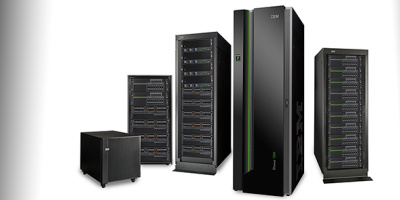AS/400 IT managers are being presented with a baffling array of network computing architectures designed to lower your Total Cost of Ownership (TCO), increase user efficiency, and provide for future network expansion and capabilities. Affecting this process, a technical and marketing chess game is currently being played out to determine the future architecture of the network computing environment in our IT shops. This match offers us a number of different ways we can network our organizations, and the winners stand to control our networking environment for years to come.
In this article, I examine the network computing chess game and provide some basic information to help you determine your next move. (Make no mistake about it; you are a player.) I look at the concepts behind network computing, the various competing architectures, and some of the issues surrounding these new technologies. While I can’t tell you everything you need to know to redesign your network today, I can give you some basic information to help you evaluate your options.
The Opening: What Is Network Computing?
Start with a simple idea. The ideal networking device—be it a PC, network computer, or other type of device—should satisfy the following criteria:
• It is inexpensive.
• It has a unique identity on the network and the Internet.
• It has complete access to all the information it needs, wherever that information resides, and can quickly present that information through a powerful local user interface.
• It is always connected to the network.
• It has extremely low configuration and maintenance costs for performing its function (a fraction of today’s PC maintenance costs).
• You can change its configuration on the fly from a remote location. In an ideal world, one of these network devices would be on every desktop. Network computing is a very broad term that describes how you provide these functions to client network devices. With network computing, these functions are distributed between your desktop network clients and the centralized servers to which they are connected (via your network or the Internet). The servers provide software and data to the clients on
demand, and the clients have enough processing power to support a powerful user interface. When evaluating network computing, IT managers must think about the network architecture of their information systems, how users access widespread information, and how much it will cost to deploy and maintain these systems. The goal, of course, is the best information access at the lowest cost.
To continue this analysis, it’s also important to explain how network computing is different from a network computer. A network computer is an intelligent device that functions solely as a client to a network computing server. This device is a very simple desktop machine that contains little or no disk storage, a lower-speed processor, and graphics and basic I/O capabilities. It communicates with a larger server that does some (or all) of the processing and sends the results back to the network computer for display or printing. Although you can configure PCs to function as network computers, several vendors offer specific hardware devices that can be classified as network computers. (See “The Nuts and Bolts of Thin-client Hardware” for a review of the current marketplace.)
One problem in trying to create a definition of a network computer is that no one wants to use the term network computer anymore. There are several reasons for this reluctance, but many people believe it took hold because Oracle and Sun unsuccessfully tried to introduce Java-based network computers a few years ago, so now different vendors have different terms for a network computer. You may hear vendors refer to them as thin clients, network or Internet appliances, or a number of other terms. The marketing of these devices is interfering with our understanding, and that hinders the technology’s acceptance. The important point to remember is that network computing is a rapidly changing marketplace struggling to find its vocabulary and default technology.
Further complicating the situation is the fact that at least four competing architectures are attempting to carry the network computing banner. These architectures work with different server systems, including Java-based servers, Microsoft Windows NT Terminal Server Edition, standard Intel PC file servers, and UNIX servers. Contrary to what some marketing people might say, the network computing marketplace is not homogeneous, nor is it predestined to be played out in any one particular way. You need to evaluate your options carefully to find the solution that best fits your current and future networking environment.
The Middle Game: Network Computing Client Types
Before I discuss the different network computing architectures, it is important to understand the types of clients each architecture deals with. There are three different types of network devices that a network computing environment will service. Be aware, however, that the lines between these devices are often blurry, so you may see different definitions coming out of different quarters. For our discussion, let’s define the following client types as the basic architectural building blocks of a network computing environment:
• Fat client. A device in which the operating system and applications reside locally on the hardware. Applications are executed on the client, and data is stored either on the client or on the server. Most traditional PCs are considered fat clients.
• Thin client. A device in which the operating system resides locally on the hardware. Applications are downloaded from a central server and executed on the client hardware, but the resulting data is stored on the central server. Java-based network computers, Net PCs, and managed PCs are thin clients.
• Ultra-thin client. A device with a small operating system that processes only graphical displays. All application processing occurs on a central server, and only the results of that processing are displayed on the client. The data resides on the central server. Windows-based terminal devices are ultra-thin clients.
Each network computing architecture is designed to service one of these clients, and the architecture you select will determine what clients and servers you install.
An Overview of Strategies: Network Computing Architectures
The four basic types of network computing architectures you can install are as follows:
• Java-based network
• Microsoft Windows NT Terminal Server (TSE) network
• Net PC network
• X.11 network for UNIX server Let’s look at each architecture in detail.
• Java-based networks are based on a thin-client model. As shown in Figure 1, this architecture downloads applications from the Java server and executes them locally on a PC with a Java Virtual Machine (JVM) or on a Java-based network computer. For complicated processing, you can run heavy-duty applications directly on a Java server (such as an AS/400 or a UNIX box), and the results can be sent to the client, so this technique offers a little more flexibility than other architectures. All graphical processing is performed on the client, and data is stored on the server. Client applications can be stored in ROM or in flash memory so the client has an “instant-on” desktop that starts from local memory. AS/400 access can be gained from any product or application that reaches the AS/400 through a Web browser or a Java-based AS/400 connectivity package.
• A Microsoft Windows NT Terminal Server Edition (TSE) network (Figure 2) is based on the ultra-thin client model. Here, a Windows NT 4.0 server that has Citrix MetaFrame installed acts as your network computing server. This architecture works with Windows clients and Windows-based terminals, although some other types of clients, such as UNIX workstations, Macintosh desktops, and Java Virtual Machines, can also access your TSE server. Application processing is performed on the server, and the results are sent back to the client. Data is stored on the server. As opposed to the Java-based networks, graphical processing is also performed on the Windows NT server, and only the results are sent back to the client. While this setup allows you to use extremely lightweight client software, server graphical processing can create a capacity problem on your Windows NT server that may force you to install multiple servers and implement load- balancing techniques to handle the demand. For AS/400 access, Client Access for Windows 95/NT or the new Client Access Express for Windows (the Express client) can be run on a Windows TSE for user access.
• A Net PC network (Figure 3) is a thin-client model that is similar to the classic Network Operating System (NOS) model. Applications are downloaded from a central server (such as a Windows NT or Novell NetWare server) and executed locally on the PC. Graphical processing is done at the client desktop, and data is generally stored on the network. A Net PC usually doesn’t contain expansion slots or a local hard drive. (In some cases, however, the Net PC may use a local hard drive for caching purposes but not for application execution.)
Alternatively, you may hear a Net PC referred to as a managed PC, which is basically a normal PC without a floppy disk drive or a CD-ROM. A Net PC network takes advantage of the central server’s user configuration and security features to control access to centrally loaded network software. Since the Net PC doesn’t contain input drives, maintenance and configuration are also controlled from the central server. For Microsoft networks, this maintenance is controlled through Microsoft’s Zero Administration for Windows (ZAW) Initiative. Your clients communicate with your AS/400s by using your usual AS/400 connectivity software.
• An X.11 network for UNIX servers is another ultra-thin-client model for a UNIX environment (Figure 4). In this network, an X.11 server on a UNIX network server serves X applications to PCs with PC X server software installed, X terminals, or network
computers that have built-in X servers. The application processing is performed on the server, while the graphical processing is performed on the client. Data is stored on the server.
In addition, you may run into other products/techniques that are variations on these architectures or expand network computing into different areas (such as GraphOn’s jBridge, which allows Java-based network computers to access newer 32-bit Windows applications on a Windows NT server, or the UNIX-based SCO Tarentella server, which attempts to provide any-client-to-any-server connectivity). As I mentioned before, the network computing arena is large and diverse, containing many different solutions for the same needs.
The End Game: Why Network Computing Hasn’t Taken Off...Yet
With all these perceived benefits—lower TCO, inexpensive hardware, flexibility—you have to wonder why thin-client and ultra-thin-client network computing hasn’t totally taken over the world. The hardware and software are in place. What is everyone waiting for?
The first thing to realize is that the climate for deploying network computing and network computers is different than it was when PCs first became available. At the dawn of the PC age, PCs infiltrated organizations through home users and “rebel” departments that sneaked them in when IT wasn’t looking. The PC was pretty much an unstoppable movement once users realized how these machines could improve their work. Today, however, nobody outside of IT is going to install a network computer, much less a network computing environment. The shift to network computing is very much vendor- management-IT driven, an environment that will slow down its adoption.
Because there is no grassroots movement to install network computing, it requires both corporate planning and approval as well as a change in existing technology to implement. IT managers must realize its benefits, write some checks, and then sell their PC-dependent employees on the concept. It’s a longer process to change an already existing environment that, for the most part, works. Unlike the rise of PCs, there is an entrenched technology (standalone and already-networked PCs) that needs to be reworked to make the move to a fully distributed network computing environment.
Next, there is the Achilles’ heel of network computing: server setup. While vendors sing the praises of how easy it is to set up thin and ultra-thin clients, the reality is that setting up the server end (the computers that run the processing and distribute the applications and data) is much more complicated. When you’re selling ease of configuration on the desktop, setup complexity doesn’t vanish. It merely gets shifted to the network servers. The result is that, as you deploy a network computing environment, it will be a long process to configure the central servers correctly and deploy the first few units. After that, it should be simple to expand the network, but the trick is in getting started, and many people may be put off by the learning curve. Distributed network computing has a fairly high learning startup cost.
This isn’t to say that the network computing shift won’t happen. In 1999, there have already been many high-profile sales of thin and ultra-thin client technology to large organizations, with IBM scoring many of the large thin-client hardware sales. However, personal computer sales also continue to perform well, so there is a mixed message in the marketplace.
Will thin and ultra-thin clients in a network computing environment completely replace today’s fat client PCs? Probably not, but they will take their place next to PCs in the corporate environment as more companies find uses for these types of architectures and network devices that aren’t as “fat” as a PC. Only time will tell who will win this particular chess game, but I recommend that you keep an eye on the network computing marketplace. This technology will continue to grow in the coming years.
Check
Thin-client Model
 |
 |
• Run applications
• Graphical processing
• Stores data
• Downloads applications
• Runs heavy-duty applications
Figure 1: A thin-client model, the Java-based network mostly downloads applications to a PC or NC for execution.
Ultra-thin-client Model
 |
 |
 |
Display results
 |
• Executes applications
• Performs client graphical processing
• Stores data
Figure 2: A Windows NT Terminal Server network is an ultra-thin-client model that does all the processing for its network clients.
Thin-client Model
Managed PC
 |
PC
Net PC
• Execute applications
• Perform graphical processing
• Downloads applications
• Maintains and configures clients
• Stores data
Figure 3: A Net PC network is another thin-client model that configures and maintains its client Windows desktops.
Ultra-thin-client Model
PC with X-server
Software NC with X-Servers
• Execute applications
• Perform graphical processing
 |




















 More than ever, there is a demand for IT to deliver innovation. Your IBM i has been an essential part of your business operations for years. However, your organization may struggle to maintain the current system and implement new projects. The thousands of customers we've worked with and surveyed state that expectations regarding the digital footprint and vision of the company are not aligned with the current IT environment.
More than ever, there is a demand for IT to deliver innovation. Your IBM i has been an essential part of your business operations for years. However, your organization may struggle to maintain the current system and implement new projects. The thousands of customers we've worked with and surveyed state that expectations regarding the digital footprint and vision of the company are not aligned with the current IT environment. TRY the one package that solves all your document design and printing challenges on all your platforms. Produce bar code labels, electronic forms, ad hoc reports, and RFID tags – without programming! MarkMagic is the only document design and print solution that combines report writing, WYSIWYG label and forms design, and conditional printing in one integrated product. Make sure your data survives when catastrophe hits. Request your trial now! Request Now.
TRY the one package that solves all your document design and printing challenges on all your platforms. Produce bar code labels, electronic forms, ad hoc reports, and RFID tags – without programming! MarkMagic is the only document design and print solution that combines report writing, WYSIWYG label and forms design, and conditional printing in one integrated product. Make sure your data survives when catastrophe hits. Request your trial now! Request Now. Forms of ransomware has been around for over 30 years, and with more and more organizations suffering attacks each year, it continues to endure. What has made ransomware such a durable threat and what is the best way to combat it? In order to prevent ransomware, organizations must first understand how it works.
Forms of ransomware has been around for over 30 years, and with more and more organizations suffering attacks each year, it continues to endure. What has made ransomware such a durable threat and what is the best way to combat it? In order to prevent ransomware, organizations must first understand how it works. Disaster protection is vital to every business. Yet, it often consists of patched together procedures that are prone to error. From automatic backups to data encryption to media management, Robot automates the routine (yet often complex) tasks of iSeries backup and recovery, saving you time and money and making the process safer and more reliable. Automate your backups with the Robot Backup and Recovery Solution. Key features include:
Disaster protection is vital to every business. Yet, it often consists of patched together procedures that are prone to error. From automatic backups to data encryption to media management, Robot automates the routine (yet often complex) tasks of iSeries backup and recovery, saving you time and money and making the process safer and more reliable. Automate your backups with the Robot Backup and Recovery Solution. Key features include: Business users want new applications now. Market and regulatory pressures require faster application updates and delivery into production. Your IBM i developers may be approaching retirement, and you see no sure way to fill their positions with experienced developers. In addition, you may be caught between maintaining your existing applications and the uncertainty of moving to something new.
Business users want new applications now. Market and regulatory pressures require faster application updates and delivery into production. Your IBM i developers may be approaching retirement, and you see no sure way to fill their positions with experienced developers. In addition, you may be caught between maintaining your existing applications and the uncertainty of moving to something new. IT managers hoping to find new IBM i talent are discovering that the pool of experienced RPG programmers and operators or administrators with intimate knowledge of the operating system and the applications that run on it is small. This begs the question: How will you manage the platform that supports such a big part of your business? This guide offers strategies and software suggestions to help you plan IT staffing and resources and smooth the transition after your AS/400 talent retires. Read on to learn:
IT managers hoping to find new IBM i talent are discovering that the pool of experienced RPG programmers and operators or administrators with intimate knowledge of the operating system and the applications that run on it is small. This begs the question: How will you manage the platform that supports such a big part of your business? This guide offers strategies and software suggestions to help you plan IT staffing and resources and smooth the transition after your AS/400 talent retires. Read on to learn:
LATEST COMMENTS
MC Press Online